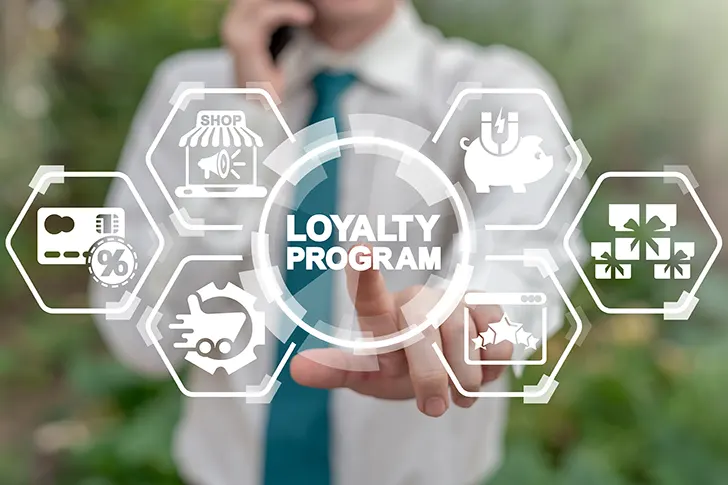
Jump to:
- Loyalty 101
- Benefits of loyalty programs
- Types of loyalty programs
- Points-based program
- Tiered loyalty programs
- Fee-based loyalty programs
- How to create an innovative program
- Set objectives
- Choose your system wisely
- Define how customers earn points
- Reward early and often
- Promote the program
- Make the most of your POS system
- Conclusion
Have you ever thought about creating a loyalty program but didn’t because you thought it was too complicated? The fact is, you don’t need to be a Fortune 500 company to build and implement a slick solution. Loyalty programs have come a long way since the days of Subway stamps, with today’s businesses harnessing the latest digital technologies to drive engagement and sales. Here’s how you can be one of them.
Loyalty 101
Loyalty programs are marketing strategies that businesses use to motivate customers to generate repeat business. These programs offer goodies like exclusive and early access to new products, members-only discounts, and other privileges like free shipping to keep members loyal and engaged. To join a loyalty program, customers usually register their personal information such as their phone number and receive a digital ID or membership card.
A couple of basics worth noting:
- Loyalty programs should be easy to use.
- They should allow customers to earn points or rewards quickly.
Benefits of loyalty programs
Effective loyalty programs are a huge boon for businesses because they keep your best customers close. Case in point: repeat customers, while comprising around 8% of all visits, account for about 40% of revenue. Here are some other perks for businesses.
Benefit 1: Bigger spends
According to an Accenture report, 57% of consumers spend more on brands to which they are loyal. Likewise, another survey showed that over half of respondents would spend more on a brand they’re devoted to even if cheaper options exist.
Benefit 2: Customer retention
As Sekure explored in a recent article, repeat customers are far more valuable than new customers, while retaining customers is far cheaper than acquiring them. Loyalty programs keep consumers engaged—which is critical because people base their purchases on more than just price. Elements like shared values and emotional connections, both of which can be fostered via loyalty, are also important.
Benefit 3: Customer referrals
Satisfied loyalty-program members are more likely to spread the word to friends and family. In fact, customers referred by members of loyalty programs have a 26% higher retention rate.
Benefit 4: Data trove for merchants
Customers aren’t the only ones who benefit from loyalty programs. For merchants, loyalty programs provide actionable insights because they make it possible to track purchases and consumer behavior. The resulting patterns, habits, and trends can then be used to improve customer experience and tailor offerings.
Types of loyalty programs

Points-based program
Points-based programs are easily the most common and popular customer loyalty programs, and for good reason—they are easy to implement and give customers a wide range of redemption possibilities. An example of a points program is Petsmart’s Treats program whereby you collect points your customers can redeem to spend on products and services similar to gift cards.
Pros
- Free sign-up, which translates into a low barrier to entry
- A good starting point for collecting customer data
- Potential to offer extra points to drive spending
Cons
- Accumulating a meaningful number of points can take a long time
- Everyone’s got one
- Lower customer engagement
Tiered loyalty programs
Unlike points-based programs, tiered loyalty involves categorizing customers based on how much they spend. They incentivize members by giving customers a goal. As they spend more and move up to higher tiers, they can access more desirable benefits, many of which go beyond material and into the realm of experiential. Tiered programs are a compelling proposition because they improve retention among your most valuable customers. According to McKinsey, 60% of paid loyalty members are more likely to spend more after subscribing, while this figure falls to 30% for free loyalty programs.
Pros
- An excellent way to create exclusivity and status
- Best rewards go to the top customers
- Top tiers motivate members to increase spending
Cons
- Potentially higher barrier to entry due to limited benefits of lower tiers
- Less suited to certain sectors, such as restaurants
- Potential to alienate members who are downgraded
Fee-based loyalty programs
These fee-based strategies are akin to membership programs. Customers pay recurring or annual fees in exchange for access to a merchant (Costco, for example) or for access to perks (Amazon Prime comes to mind). To be effective, the benefits conferred by paid programs must trump the fees, so the extras must be worthwhile and engagement high. But when implemented well, these programs are worth it. According to McKinsey, consumers in paid programs spend more, spend more frequently, and are more likely to engage with a brand’s overall offerings.
Pros
- Program costs can be offset with member fees
- Useful and easy-to-understand rewards
- Consumers are more likely to spend more after joining
Cons
- More difficult to implement and operate
- Higher upfront costs can be a turn-off
- Members have higher expectations
How to create an innovative program
So, you want to start a loyalty program but aren’t sure where to begin? Your POS system is a good starting point, as many offer affordable baked-in programs that you can personalize with your own branding. You can also use a third-party provider, many of which offer basic solutions like digital punch cards. Whichever you choose, here are a few ground rules to help you build an innovative program that sticks.
Set objectives
Before you build out a loyalty program, start by asking yourself what the primary objective is. For example, you may be looking to increase the average spend, drive repeat visits, or increase churn. Once you’ve nailed down your goals, they will inform what business areas you target.
Choose your system wisely
As mentioned earlier, there are several ways to incentivize customers. Before deciding on what kind of loyalty system you’re going to implement, it’s worth doing your research to see if one or the other—say, points vs. tiered—is better suited to your industry. In the restaurant sector, for example, point-based systems are the norm. Starbucks, for instance, recently did away with its tiers to drive the adoption of its loyalty program among new members and added an impressive 3.1 million members over the following three quarters.
Define how customers earn points
If you end up choosing a points-based system, you need to determine how customers will earn points. For example, what is the minimum spent per visit to earn points? Likewise, how many points will be given depending on the amount spent or item or category?
Reward early and often
It’s essential to engage your customers early on and make them feel loved. To that end, get them earning points right off the bat. Reward them for setting up an account, and then provide ample opportunities to keep amassing points. These could include dishing out points for celebrating a birthday, interacting with your brand on social media, and even reviewing a product online.
Promote the program
Spread the word and let people know that you are offering a loyalty program. Post on your website and social media, plaster notices on your check-out counter, and if you have a mailing list, then drop a line to your customer base. Tell them how to join and earn points and rewards. And be sure to make a compelling case for why they should join. Did someone say free shipping?
Make the most of your POS system
Lastly, it’s worth noting how a POS system can help with your loyalty program. You might think that instituting and administering a loyalty program—not to mention managing inventory—will be challenging, but it’s not the case. Today’s POS systems keep your omnichannel data in one place, so your online and in-store purchases and loyalty redemptions are all updated in real-time.
Your POS system can also help you evaluate your program’s performance. You’ll know how many rewards have been redeemed and which items are most popular, and you’ll be able to analyze customer behavior post-enrollment and make any necessary changes.
POS systems also allow you to group loyalty members based on criteria such as demographics, birthdays, and purchase history so that you can target specific groups. A real-world situation might be where you have certain products that aren’t selling, and you need to turn them over. You could create an email (or SMS) group of members who purchased the item(s) previously and send a promotion whereby they earn 3X points, for example. They earn extra points (or get free shipping), and you ditch unwanted products. It’s a win-win.
Conclusion
Loyalty programs have many benefits, and good ones can help drive repeat business and brand loyalty. Average ones, however, risk going unnoticed among consumers and are unlikely to change their behavior or build brand loyalty in any meaningful way. And, most importantly, loyalty solutions aren’t just for big corporations. Your small- or medium-sized business can quickly implement one and reap the rewards. If you have any questions on loyalty programs or anything else payment-related, get in touch with Sekure today, and we’ll help you out.













